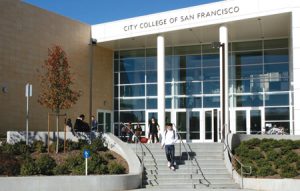SF International High School Span Students Figure Out College and Scholarship Applications
By Martha Sessums, President, ACE
“What’s different this semester than last semester?”
The question was asked by Kyle Halle-Erby to a group of Span students at City College of San Francisco (CCSF) in the Latino Services Network (LSN) conference room. It was a weekly Monday Span meeting of a dozen students that had graduated from San Francisco International High School (SFIHS) and are now attending college. Halle-Erby is the Span Program Director at SFIHS.
The student’s answers generally had one theme – getting used to fitting a college schedule into a life filled with work, family and friends.
“I’m not so lost this semester,” said Talley who graduated from SFIHS in 2016. “I need to work, and that’s a challenge, but I go to school and chill with my friends too. I’ve gotten used to things now.”
Span is part of SFIHS’s ACE Learning Center that supports high-risk graduates through their first year of college. It is designed to support students through the unique academic, administrative and cultural challenges they face as newcomer immigrants, English learners and first-generation college students on a university campus. The weekly college campus meetings provide advocacy, academic counseling and leadership development for high school graduates enrolled in college.
The major part of the Span meeting was information on applying for scholarships, specifically the Mosaic Scholars Program. This is a $1,000 award paid over two semesters for books, supplies, transportation, childcare and other college-related necessities.
Applying for scholarships is never easy, and I wish I had been given the advice that Anastasia Fiandaca, LSN Counselor, gave to the Span students when I was applying for scholarships. The tips offered were on a flurry of green, yellow, blue and white papers. The discussion included meeting deadlines, following rules, tips on writing the personal statement or essay that is required for most scholarships, along with secrets and tips for getting a great letter of recommendation. Plus a scholarship vocabulary list so applicants can keep up with the discussion.
The advice started with some basics. “Applications are not text messages,” said Fiandaca. “You need to capitalize names, cities, streets, etc. Use blue or black ink, not pencil, and write neatly.”
One of the most important things discussed was how to make a plan to complete the application and turn it in on time. List all the parts that must be completed, make a specific plan for when to work on it, plus plan what is specifically going to be done during the hours allotted. For some people, this is easy. But for students who work, take care of siblings, do home chores, need some time with friends, plus go to school, do the homework and maintain a good GPA, making a plan to complete an application can seem overwhelming.
“Allow a certain number of hours each day, but if you know Wednesday is full with your other responsibilities, then add extra time to Tuesday or Thursday,” said Fiandaca. “Just make sure you make a plan for what you are going to do.”
There was also discussion about the unknowns. What if you really don’t know what your planned major or field of study will be? Fiandaca suggested listing several answers, which will show that the applicant is giving it strong thought.
Another typical question on scholarship applications is to list volunteer or community work. But what if a student is so busy working, dealing with family responsibilities, and going to college that there is little time for volunteer work?
“It’s okay to list that you have a job and doing things to take care of your family,” said Fiandaca. “Just don’t make yourself look like you are lazy.”
The advice for writing the personal statement was a combination of following formatting and length rules, plus giving a true picture of yourself as a person who needs some financial help.
“The organizations that offer scholarships want to see that you work hard, pass your classes, get up and go to work each day and help with your family,” said Fiandaca. “They want to see that the help they offer can help you achieve all that.”
Sai is a SFIHS graduate (’15) interested in applying for the scholarship. His plan is to earn the Culinary Arts and Management degree at CCSF.
“I want to do Indian fusion food and open a restaurant one day,” he said.
Talley wants to major in criminal justice, which will eventually require a transfer to San Francisco State University.
“I was touring a morgue in Mexico City and snuck into the room where they were doing forensics on a body,” he said. “That’s when I decided I wanted to to this. What an adventure.”
And with that, Talley, Sai and the other students were off to class.

